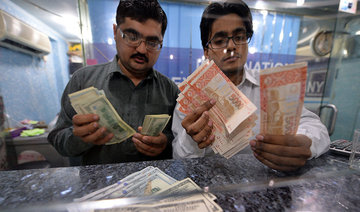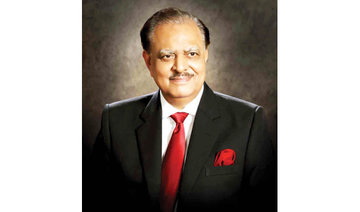KARACHI: Pakistan on Monday devalued its national currency for the third time in the current fiscal year following mounting external balance of payment pressure in the backdrop huge trade deficit, due to increasing imports and insufficient exports.
“The PKR-$ exchange rate in the interbank market closed at PKR119.84 per US dollar while witnessing an intraday low and high of PKR117 and PKR121.50 per US dollar respectively. This movement is based on foreign exchange demand-supply gap in the interbank market,” said the State Bank of Pakistan (SBP).
This is the third time that the Pak rupee has been devalued during the current fiscal year FY18. The Government had devalued the Pak rupee by around 5 percent on Dec. 8, 2017 to PKR110, and then again by around 4.5 percent to PKR115 on March 20, 2018.
“The market-based adjustment is reflective of the country’s external balance of payments position, which is under pressure due to a large trade deficit. Despite the continued growth in exports (13.3 percent in Jul-Apr FY18) and some uptick in remittances, growing imports have pushed the current account deficit to $14 billion during the first ten months of FY18, which is 1.5 times the level of deficit realized during the same period last year,” the central bank added.
SBP is of the view that this market-driven adjustment in the exchange rate, along with other recent policy measures, is expected to contain the imbalances in the external account, thereby containing aggregate demand and also facilitating the prospects for generating non-debt creating inflows.
The authorities adopted a similar methodology to weaken the national currency on Monday as was employed during the past two adjustments. “In the early hours the currency was allowed to depreciate against the dollar in the interbank market in a controlled manner, as was done previously, but this time a caretaker government is in the office,” Zeeshan Afzal, executive director research at Insight Securities, told Arab News.
Pakistan has taken steps to adjust its national currency with an international basket of currencies in real value terms following historical high current account deficit which swelled up to $14 billion or 4.4 percent of GDP.
“We believe this is much needed as Pakistan’s external account continues to deteriorate as the external current account deficit remained higher than our expectations. For FY18, we now expect CAD to be in the range of $17-18 billion or 5.4-5.8 percent of GDP,” Umair Nassir, analyst at Topline Securities, told Arab News.
Analysts believe that the Pakistan rupee is still undervalue by up to 10 percent as compared with the dollar. “Based on the Real Effective Exchange Rate, we are revising our exchange rate assumption for FY19. We now expect the Pak rupee to devalue to PKR131, further depreciation of 7 to 10 percent, by Jun 2019,” Nassir added.
As the devaluation is expected to infinite inflationary pressure, the analysts expect that the SBP will increase its policy rate from current 6.5 percent to 8-8.25 percent in the next monetary policy announcement.
Pakistan’s trade deficit during 11 months of the current fiscal year has widened to $34 billion as exports stood at $21.34 billion, while imports increased to $55.23 billion, latest figures released by Pakistan Bureau of Statistics show.
The devaluation is aimed at encouraging exports by making local products compatible in the international market. However, Federation of Pakistan Chambers of Commerce and Industry (FPCCI), apex body of industrialist and traders, negates this impression, terming it “only a short-term gain/ measure.”
“This (devaluation) shows that the previous two devaluations did not yield the desired results. I don’t think this will benefit the economy in the long term as it will make output expensive in the absence of value addition,” Syed Mazhar Ali Nasir, senior vice president of FPCCI, told Arab News.
The move also rumpled Pakistan stock exchange which closed bearish, down by 16 points. “Stocks closed lower amid midsession pressure on rupee devaluation weakening earnings outlook for the auto, cement and steel sector. The devaluation was expected and is likely to continue to fund trade deficit,” Ahsan Mehanti, senior analyst and chief executive of Arif Habib Group.
As the experts expect further devaluation, the central bank says it will continue to closely monitor the foreign exchange markets; and stands ready to ensure stability in the financial markets and curb the emergence of speculative pressures.
























